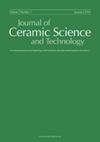Interface design and processing of bioactive microporous calcium phosphate coatings on load-bearing zirconia substrate
IF 0.4
4区 材料科学
Q4 MATERIALS SCIENCE, CERAMICS
引用次数: 0
Abstract
This study presents the design and processing of interlocked interfaces of graded bioactive calcium phosphate coatings on a load-bearing zirconia substrate. Such interfacial structures can effectively enhance bonding between the coating and substrate, and suppress the residual stress across the interfacial region. Multiple coating layers with graded interconnected micropore structures, and common phases across the layer boundary have been considered to minimize the likelihood of interfacial cracking/delamination. The Focused Ion Beam (FIB) technique was used to reveal microscopic details of the interlocked interface formed by the common calcium phosphate and zirconia phases in both the microporous coating and the dense substrate. The interface microstructure and phase characteristics in the substrate and coatings were confirmed by means of FIB-SEM and X-ray diffraction (XRD) analysis respectively. A preliminary Finite Element Modelling (FEM) study shows that graded and interconnected micropore structures in multiple coating layers and tailored material composition can further reduce the interfacial residual stresses. The flexural and bonding strength of the composite and coating/substrate interface respectively have been characterized. A preliminary and limited in vitro cell test shows that the composite has no cytotoxicity to the fibroblasts. A successful interface design is crucial for bioceramic composite design that combines strength and bioactivity to deliver a potential candidate for load-bearing application.承载氧化锆基生物活性微孔磷酸钙涂层的界面设计与加工
本研究提出了在承载氧化锆基板上设计和处理具有生物活性的分级磷酸钙涂层的联锁界面。这种界面结构可以有效地增强涂层与基体之间的结合,抑制界面区域的残余应力。考虑了具有分级互连微孔结构的多个涂层,以及跨层边界的共同相,以最大限度地减少界面开裂/分层的可能性。利用聚焦离子束(FIB)技术揭示了微孔涂层和致密基体中常见磷酸钙相和氧化锆相形成的联锁界面的微观细节。通过FIB-SEM和x射线衍射(XRD)分析,分别确定了基体和涂层的界面微观结构和相特征。初步的有限元模拟研究表明,分层、互联的微孔结构和定制化的材料组成可以进一步降低界面残余应力。对复合材料和涂层/基体界面的弯曲强度和结合强度进行了表征。初步体外有限细胞试验表明,复合材料对成纤维细胞无细胞毒性。一个成功的界面设计是生物陶瓷复合材料设计的关键,它结合了强度和生物活性,为承载应用提供了潜在的候选材料。
本文章由计算机程序翻译,如有差异,请以英文原文为准。
求助全文
约1分钟内获得全文
求助全文
来源期刊

Journal of Ceramic Science and Technology
MATERIALS SCIENCE, CERAMICS-
CiteScore
0.80
自引率
0.00%
发文量
0
期刊介绍:
The Journal of Ceramic Science and Technology publishes original scientific articles on all topics of ceramic science and technology from all ceramic branches. The focus is on the scientific exploration of the relationships between processing, microstructure and properties of sintered ceramic materials as well as on new processing routes for innovative ceramic materials. The papers may have either theoretical or experimental background. A high quality of publications will be guaranteed by a thorough double blind peer review process.
 求助内容:
求助内容: 应助结果提醒方式:
应助结果提醒方式:


